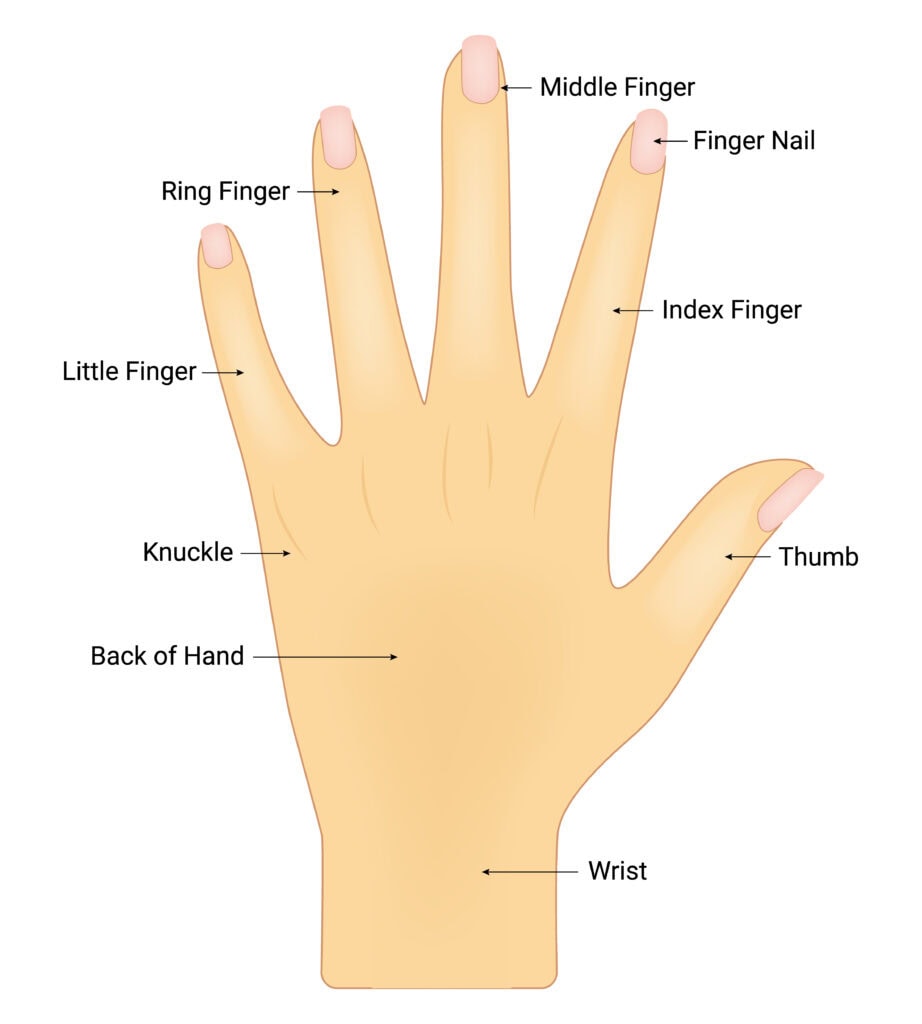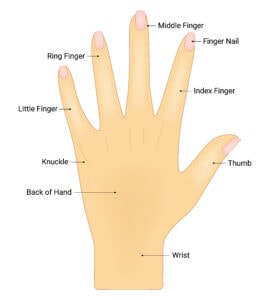Finger anatomy involves the study of the bones, joints, tendons, and ligaments that make up the fingers. This article covers the structure of finger bones, how finger joints work, the role of tendons and ligaments, and common conditions affecting fingers. By understanding finger anatomy, you can better appreciate how fingers function and how to care for them.
Key Takeaways
The human hand consists of 27 bones, including metacarpals and phalanges, each playing a key role in finger movement and hand functionality.
Finger joints, including MCP, PIP, and DIP, enable a wide range of movements essential for gripping and manipulation, while tendons and ligaments provide the necessary support and flexibility.
Common finger conditions like arthritis, fractures, and tendon injuries can significantly affect mobility, but proper care and treatment, including preventative measures and medical attention, can help manage these issues.
Finger Bones and Structure
The human hand is a marvel of engineering, comprising 27 bones, including 5 metacarpals and 14 phalanges. The metacarpals form the palm, connecting the wrist bones to the finger bones, while the phalanges make up the fingers themselves. Each finger has three phalanges, except for the thumb, which has two.
Grasping the structure of these finger bones helps appreciate their role in hand functionality, particularly the finger bone.
Proximal Phalanges
The proximal phalanges are the first set of bones in each finger, starting from where the fingers meet the hand. These bones connect to the metacarpals and are crucial for finger movement, providing a stable base for the other phalanges.
The thumb’s proximal phalanx, located between the thumb metacarpal and thumb distal phalanx, supports various thumb joints and movements.
Middle Phalanges
Middle phalanges act as a bridge between the proximal and distal phalanges, playing a key role in the bending and straightening of fingers. These bones are essential for the overall mobility and dexterity of the hand, allowing for versatile finger motion.
Positioned between the proximal and distal phalanges, the middle phalanges enhance the hand’s ability to perform intricate tasks.
Distal Phalanges
Distal phalanges are the bones at the very tips of the fingers, crucial for fine motor skills and precision tasks. These bones have a bulbous tuft at the end, which supports the fingernail and enhances tactile sensitivity.
The thumb’s distal phalanx is uniquely shaped with a rounded tuft, distinguishing it from other distal phalanges.
Joints in the Fingers
Finger joints are the hinges that allow our fingers to perform a wide range of movements. Each finger has three joints: the metacarpophalangeal (MCP), proximal interphalangeal (PIP), and distal interphalangeal (DIP) joints, while the thumb has an additional joint.
Lined with cartilage, these joints facilitate smooth motion by reducing friction.
Metacarpophalangeal Joint (MCP)
The MCP joints are where the metacarpal bones meet the proximal phalanges. These joints are crucial for hand function, allowing for flexion and extension movements that enable gripping and grasping.
Categorized as diarthrodial joints, MCP joints are key for the hand’s flexibility and dexterity.
Proximal Interphalangeal Joint (PIP)
Located between the proximal and middle phalanges, PIP joints are synovial hinge joints crucial for bending the fingers and facilitating various hand movements. The PIP joints enable the fingers to perform intricate tasks, such as typing and playing musical instruments.
Distal Interphalangeal Joint (DIP)
The DIP joints are found between the middle and distal phalanges. These joints are responsible for fine motor skills, allowing for precise movements like gripping and pinching.
The interplay between the DIP joint and the PIP joint enhances the overall flexibility and range of motion of the fingers.
Tendons and Ligaments
The mechanics of finger movement involve a complex interaction between bones, joints, muscles, tendons, and ligaments. Tendons connect muscles to bones, enabling movement, while ligaments connect bones to each other, providing joint stability.
Flexor tendons enable finger bending, while extensor tendons allow for extension.
Flexor Tendons
Flexor tendons run along the palm side of the hand and are responsible for bending the fingers. These strong, cord-like structures connect the forearm muscles to the finger bones, enabling functions that require grip and manipulation. These tendons are essential for finger flexion, enabling them to curl towards the palm.
Extensor Tendons
Extensor tendons are located on the dorsal side of the hand and are responsible for straightening the fingers. These tendons run along the back of the hand, enabling extension movements that increase the joint angle. The extensor tendon plays a crucial role in this process.
These tendons are vital for functions like lifting and releasing objects.
Collateral Ligaments
Collateral ligaments offer lateral stability to finger joints, especially at the MCP, PIP, and DIP joints, preventing lateral deviation during movements. The ulnar collateral ligaments play a crucial role in this stability.
Collateral ligaments support the metacarpophalangeal joints, enhancing the overall stability and function of the fingers.
Finger Movement and Function
Finger movements are a symphony of flexion, extension, abduction, and adduction, facilitated by a network of joints and tendons. MCP joints facilitate flexion and extension, enabling actions like gripping and grasping. Unique to the thumb, opposition allows it to touch the other fingers, a movement crucial for grasping objects.
Flexion and Extension
Flexion bends the fingers towards the palm, while extension straightens them away. These movements are vital for gripping and manipulation tasks. Flexion decreases the joint angle, while extension increases it, showcasing the dynamic range of finger movements.
Abduction and Adduction
Abduction moves the fingers away from the hand’s midline, while adduction brings them closer. These movements are crucial for tasks like playing instruments or typing.
Thumb-Specific Movements
The thumb’s unique movements, like opposition and reposition, distinguish it from other fingers. Opposition allows the thumb to touch the other fingers’ tips, crucial for grasping and pinching.
Reposition returns the thumb to its original position after opposition, enabling a variety of hand functions.
Finger Anatomy Diagram

Common Finger Conditions
Arthritis, fractures, and tendon injuries commonly affect fingers, leading to pain, swelling, and limited mobility, which can significantly impact daily activities.
Recognizing these conditions aids in effective management and treatment.
Arthritis
Arthritis often affects finger joints, causing pain, stiffness, and swelling. Osteoarthritis, rheumatoid arthritis, and psoriatic arthritis are types that affect the hands.
Treatment may include medications, physical therapy, and in severe cases, surgical options like joint replacement.
Fractures
Finger fractures usually result from trauma or impact, causing pain, swelling, and difficulty moving the affected finger. Treatment may include immobilization, rest, and, if necessary, surgical intervention.
Imaging tests like X-rays are often needed for accurate diagnosis of fractures.
Tendon Injuries
Cuts or overuse can cause tendon injuries in the fingers, leading to loss of motion or weakness. These injuries can severely limit movement and require prompt medical attention for recovery.
Treatment may involve rehabilitation exercises to restore strength and flexibility.
Finger Care and Treatment
Maintaining finger health and function requires proper care and treatment. This involves preventative care, at-home treatments, and professional medical care.
Understanding these approaches helps in managing and preventing common finger conditions.
Preventative Care
Preventative care greatly enhances finger health and prevents issues. Consider these ten tips to maintain healthy fingers:
Regularly moisturize your hands to prevent dryness and cracking.
Use ergonomic tools to minimize strain during repetitive tasks.
Take regular breaks and perform finger stretching exercises.
Avoid overuse of fingers in activities that cause strain.
Maintain a healthy diet to support joint health.
Keep your fingers warm in cold weather to prevent stiffness.
Avoid smoking, as it can impair blood flow to the fingers.
Stay hydrated to keep joints and tissues healthy.
Practice good posture to avoid strain on your hands and wrists.
Consult a healthcare professional if you experience persistent pain.
At-Home Treatments
At-home treatments help manage minor finger issues without immediate medical attention. Over-the-counter pain medications can ease discomfort from minor ailments. Rehabilitation for tendon injuries often involves exercises to restore strength and flexibility.
Professional Medical Care
Some finger conditions may need professional medical care for effective treatment. Fractures often require X-rays for accurate diagnosis and may need immobilization or surgery. Cortisone injections can reduce inflammation from tendon injuries.
Frequently Asked Questions
What are the main bones that make up the fingers?
The fingers are mainly made up of three phalanges each—proximal, middle, and distal—except for the thumb, which has just two. These phalanges connect to the metacarpal bones of the hand.
What are the primary joints in the fingers?
The primary joints in your fingers are the metacarpophalangeal (MCP), proximal interphalangeal (PIP), and distal interphalangeal (DIP) joints, while the thumb has the interphalangeal (IP) joint. These joints help your fingers move and grip effectively!
How do flexor and extensor tendons function?
Flexor tendons help you bend your fingers, while extensor tendons are in charge of straightening them. They work together to give you smooth and coordinated hand movements!
What are common conditions that affect the fingers?
Common conditions that affect the fingers are arthritis, which brings pain and stiffness, fractures from injuries, and tendon injuries that can limit motion and strength. If you’re experiencing any symptoms, it’s worth checking in with a healthcare professional.
What are some preventative measures for maintaining finger health?
To keep your fingers healthy, regularly moisturize, use ergonomic tools, take breaks, and do some stretching exercises. Remember, avoiding overuse and eating a balanced diet also play a crucial role!





